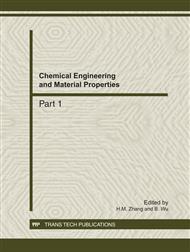p.1368
p.1375
p.1383
p.1387
p.1392
p.1396
p.1400
p.1406
p.1412
Ambient Condition Synthesis of Ag Submicron Crystallites from AgNO3, H2O2 and NH3•H2O
Abstract:
A simple and cost-effective method based on the reduction of AgNO3 by H2O2 (5 vol.%) in 2.5–5 vol.% NH3•H2O aqueous solutions at room temperature and under atmospheric pressure was developed for the synthesis of Ag submicron crystallites. X-ray diffraction patterns demonstrated that the resultant products were pure cubic phase Ag powders. Field emission scanning electronic microscopy images showed that the Ag powders synthesized in 2.5 and 5 vol.% NH3•H2O aqueous solutions comprised submicron crystallites with the sizes of about 355–580 and 200–650 nm, respectively. Besides, the possible formation mechanism of Ag powders in the present system was also proposed.
Info:
Periodical:
Pages:
1392-1395
Citation:
Online since:
December 2011
Authors:
Price:
Сopyright:
© 2012 Trans Tech Publications Ltd. All Rights Reserved
Share:
Citation:


